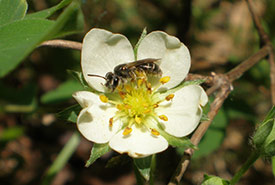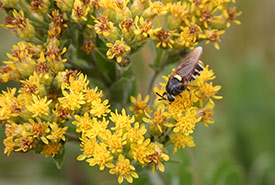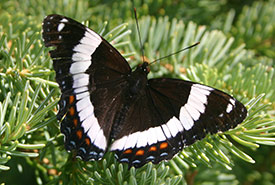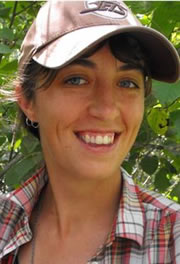It's the little things that matter

Miner bee on wild strawberry (Photo by Marika Olynyk/NCC staff)
A trip to the cottage is often a reminder to stop and enjoy the small things in life. And the small things can be rather small indeed. On any given summer day, we are surrounded by thousands of pollinating insects going about their business. The world of pollinators is a hidden secret in our own backyard, and it is much more than just familiar honey bees. From tiny flower flies to showy butterflies, and from buzzing bumble bees to unassuming beetles, the diversity of the pollinator world is astounding.
Despite being an animal lover since childhood, I spent much of my life oblivious to most insects around me; I was concerned mainly with avoiding mosquitoes. A happy side effect of learning to stop and smell the roses was meeting the other visitors to those very same roses. Now I find it fascinating to observe the pollinators in my garden: the bees moving systematically from flower to flower, the flower flies hovering steadily and silently above the blooms, the butterflies sunning themselves on a perch. A busy bee isn’t interested in stinging. My three-year-old niece and I have been captivated watching from only a couple of feet away, completely ignored by the bumble bees that have more important things to worry about than curious onlookers.

Soldier fly on stiff goldenrod (Photo by Diana Bizecki Robson/Manitoba Museum)
When it comes to pollinators, the words we often associate with insects, such as nuisance or pest, are completely unfitting. Concepts like beneficial, sustaining and industrious are much more appropriate to describe the roles that pollinators play in our lives. Not only do these flower visitors pollinate one third of our food crops, they are at the heart of many ecosystems, sustaining most of the plants that form the basis of all life on Earth. Unfortunately, we have seen declines in our wild pollinators over recent decades. It is now more important than ever to maintain their habitats and the wild spaces they need to survive.
As you get your cottage ready for summer, here are some ideas to help out the pollinators in your backyard.
Leave wild space on your property
Just like other wildlife, pollinators benefit from the natural areas that are found in cottage country. Unmowed and uncleared areas contain the wild plants, hidden spaces and natural diversity that pollinating insects need to complete their life cycles.
Avoid insecticides and herbicides, if possible

White admiral butterfly (Photo by Diana Bizecki Robson/Manitoba Museum)
Pollinators can be harmed unintentionally by pesticides meant for other purposes. Herbicides can kill the plants that pollinators need to survive, while insecticides can directly harm or kill pollinators. If possible, choose not to use insecticides on your property and try to find other forms of pest management. Avoid purchasing plant material with neonicotinoids and avoid spraying flowering plants with insecticides or herbicides while they are in bloom.
Use native plants in your garden and landscaping
If you are a gardener, or if you want to re-create some habitat on your property, consider using plants that are local to your region. Not only are these plants useful to an array of wild pollinators who prefer them over typical garden varieties, they generally require less watering and maintenance. Using native plants has the additional benefits of creating shoreline stability, water filtration and attracting other wildlife, such as birds and mammals.
Native plants will vary by region, but here are some to consider for many cottage areas. Try to find local suppliers when possible:
Wildflowers and grasses: Solomon’s seal, bunchberry, aster, wild red columbine, Canada anemone, baneberry, pearly everlasting, violet, honeysuckle, bedstraw, wild strawberry, bluejoint/marsh reed grass, manna grasses.
Shrubs and trees: Wild rose, willow, buffalo berry, Labrador tea, bog laurel, bog rosemary, blueberry, wild cherry, Saskatoon berry, meadowsweet, wild raspberry.
This story was originally published in the May issue of The Cottager magazine and is reposted with permission.


